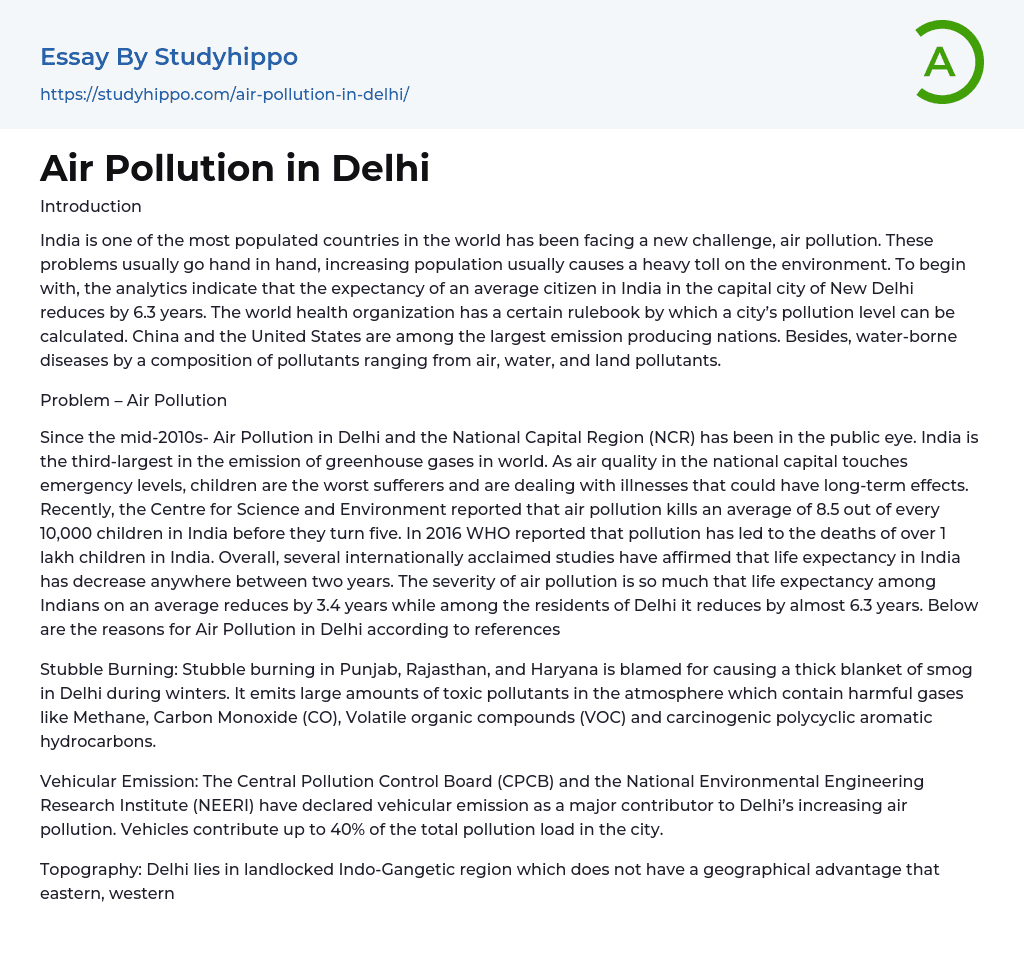Introduction
India is one of the most populated countries in the world has been facing a new challenge, air pollution. These problems usually go hand in hand, increasing population usually causes a heavy toll on the environment. To begin with, the analytics indicate that the expectancy of an average citizen in India in the capital city of New Delhi reduces by 6.3 years. The world health organization has a certain rulebook by which a city’s pollution level can be calculated. China and the United States are among the largest emission producing nations. Besides, water-borne diseases by a composition of pollutants ranging from air, water, and land pollutants.
Problem – Air Pollution
Since the mid-2010s- Air Pollution in Delhi and the National Capital Region (NCR) has been in the public eye. India is the third-largest in the emission of
...greenhouse gases in world. As air quality in the national capital touches emergency levels, children are the worst sufferers and are dealing with illnesses that could have long-term effects. Recently, the Centre for Science and Environment reported that air pollution kills an average of 8.5 out of every 10,000 children in India before they turn five. In 2016 WHO reported that pollution has led to the deaths of over 1 lakh children in India. Overall, several internationally acclaimed studies have affirmed that life expectancy in India has decrease anywhere between two years. The severity of air pollution is so much that life expectancy among Indians on an average reduces by 3.4 years while among the residents of Delhi it reduces by almost 6.3 years. Below are the reasons for Air Pollution in Delhi according to references
Stubble Burning: Stubble burning i
Punjab, Rajasthan, and Haryana is blamed for causing a thick blanket of smog in Delhi during winters. It emits large amounts of toxic pollutants in the atmosphere which contain harmful gases like Methane, Carbon Monoxide (CO), Volatile organic compounds (VOC) and carcinogenic polycyclic aromatic hydrocarbons.
Vehicular Emission: The Central Pollution Control Board (CPCB) and the National Environmental Engineering Research Institute (NEERI) have declared vehicular emission as a major contributor to Delhi’s increasing air pollution. Vehicles contribute up to 40% of the total pollution load in the city.
Topography: Delhi lies in landlocked Indo-Gangetic region which does not have a geographical advantage that eastern, western or southern parts of the country enjoy. There is no sea breeze to disperse the concentrated pollutants.
Construction Sector: Due to a huge increase in construction work in Delhi-NCR is another culprit that is increasing dust and pollution in the air.
Fire Crackers: Despite the ban on cracker sales, firecrackers were a common sight observed this Diwali. It may not be the top reason for air pollution, but it contributed to its build-up.
Solution
As air pollution in Delhi NCR has become a regular phenomenon, therefore to bring down the silent killer, the government needs to move beyond the bare minimum to concrete grassroots steps to limit the threat. Various measures have been described below:
Stubble Burning: The most efficient technology to counter crop burning now is Turbo Happy Seeder (THS) which is a machine mounted on a tractor that not only cuts and uproots the stubble but can also drill wheat seeds in the soil that have just been cleared up. The straw is simultaneously thrown over the sown seeds to form a cover.
The urge for public
transport has long been anticipated as a potential solution. However, we are far from implementing it on the ground. The current public transport system is disintegrated. We need to integrate it physically ensuring that it is reliable, comfortable and provides last-mile connectivity but without additional cost. Personal vehicle users enjoys comparatively more affordable because of the subsidy given to them. Therefore, parking fees, minimal charges for using the roads and cost of congesting the roads must be in alignment with the direction to incentivize personal transport.
Municipal Planning: Burning of municipal solid waste and industrial waste in the open is contaminating the air a lot. The demand is to build institutional capacity for implementation and enforcement and have the necessary legal back-up for compliance and strong deterrence.
Conclusion
The above observations says that air of delhi is polluted especially in matter of particular form. The study says, vehicular pollution alone is responsible for 72% of total air pollution load as estimated by activity based approach by IPCC. However, the present study finds that it is not only vehicular pollution, rather, domestic pollution, industrial emission, road dust, and garbage burning also have a large share in Delhi’s total pollution load. Furthermore, the construction of infrastructure including large residential complexes potentially contributes to Delhi’s air pollution load.
- Animal Welfare essays
- Zoo essays
- Plastic essays
- Waste Management essays
- Climate Change essays
- Global Warming essays
- Conservation essays
- Recycling essays
- Environment Pollution essays
- Plastic Pollution essays
- Air Pollution essays
- Carbon Dioxide essays
- Climate essays
- Deforestation essays
- Ecology essays
- Endangered Species essays
- Environmental Issues essays
- Environmental Protection essays
- flood essays
- Greenhouse Gas essays
- Hurricane essays
- Nature essays
- Pollution essays
- Renewable Energy essays
- Sustainability essays
- Tornado essays
- Traffic essays
- Tsunami essays
- Water Pollution essays




